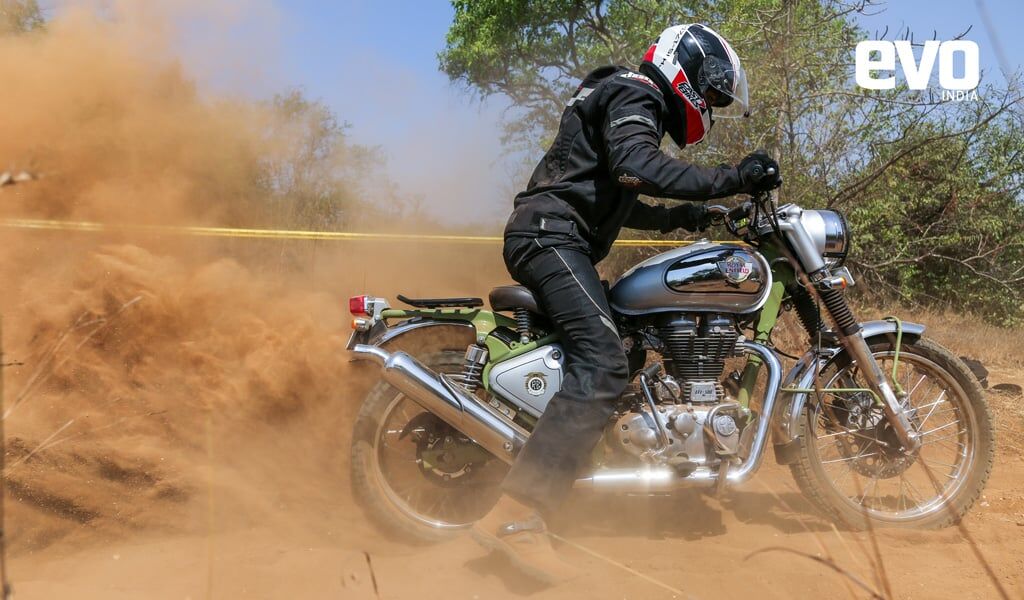Royal Enfield Bullet Trials Works Replica test ride review
Paying tribute to the Trials motorcycle from the late 40s and early 50s, Royal Enfield takes out a page from its history in motorsport.
 Paying tribute to the Trials motorcycle from the late 40s and early 50s, Royal Enfield takes out a page from its history in motorsport.
Paying tribute to the Trials motorcycle from the late 40s and early 50s, Royal Enfield takes out a page from its history in motorsport.Indians love classic motorcycles, especially the ones wearing the Royal Enfield badge. A large part of Royal Enfield’s success story can be credited to its lineage. Today, such is the following for the brand that every Tom, Dick and Harry signs a cheque just for the experience. And there are almost 60,000-75,000 such people doing so every month. Cashing on the same trend, Royal Enfield has given its most popular Classic model an even more classic makeover. Behold the Bullet Trials Works Replica; yes that’s what they’re calling it. It’s almost the same as the Bullet, albeit with minor changes to the bike, which ultimately add dollops of history – this time with respect to off-road competition. But should you be shelling out extra money for it or simply go for the more purposeful Himalayan?
What’s new on this Royal Enfield?
Banking on the 1948 and later years’ trials variants of the Bullet, you get knobbies at both ends supplied by Ceat, a dual disc setup along with permanent dual-channel ABS, rubber gaiters and coloured frames. Up next is the upswept exhaust, short front and rear fenders,a fork brace, a handlebar brace, and a single-seat along with a carrier (instead of the pillion seat). Both the 350 as well the 500 also get a host of accessories to make them stand out even further. Brace pad, bash plate, race decal (a la Ducati Scrambler Cafe Racer) and a headlight protector. How do you tell the two apart? Well, the 500 gets the same livery as Royal Enfield’s most decorated Trials rider, Johnny Brittain – a green frame with a silver paint job, replete with a chrome finish and pinstripe on the tank. The 350 gets a red frame with a silver paint job, and draws inspiration from a few of their later competition bikes.
How does it go?
We tried out only the 500 in 19 Degree North Adventure Zone which has several trails varying in difficulty levels. Unfortunately, the 499cc motor develops the same amount of power and torque as the Bullet at 27.2bhp and 41.3Nm. The weight too is exactly the same at 192kg. We were already aware that the 500 feels lethargic and it’s no different with the Trials. Despite its long stroke engine, the Trials struggled over climbs in the second cog. Of course, the lack of a tacho means you have no clue about what the engine is doing but it definitely feels lazy. The forward-set pegs don’t do much for the Trials package either, though the low saddle height does help in getting a foot down easily. Ironic though, because the whole point of Trials was to cross obstacles without your feet touching the ground.
Suspension travel isn’t much either, and we ended up bottoming out on several occasions. In fact, thanks to its low ground clearance of 135mm, the bash plate too plays a crucial part. The 19-18in rims shod with Ceat Pro Gripp tyres fared really well though. Even the ride is comfortable and the Trials should make for a comfortable cruiser, especially on the highways.
The ABS, however, is non-switchable (why RE, why?) and like almost all other Royal Enfields, except the 650 Twins, the brakes feel wooden and inadequate.
Buy it or not?
The Bullet Trials are great for those who want to stand apart from the crowd. The Bullet and Classic are almost as common as a Pulsar today and a lot of buyers are heading towards Jawa just to try out something different. They are just like Maruti Suzuki with the RS badge, offering nothing substantial but a cosmetic update over the standard version. However, a lot of buyers essentially go for the Bullet to head to Ladakh and hence end up piling on a lot of mods. Royal Enfield isn’t charging a premium for the Trials; the 350 costs about Rs 9000 over the Classic, while the 500 is just Rs 6000 costlier. Also, the standard kit on the Trials includes the luggage rack, knobbies and brace pad, which is definitely a great starter pack for Ladakh. But wouldn’t you rather spend the money on a Himalayan and still end up with some cash in hand? I know I would.
Is the Yamaha MT-15 just an R15 minus the fairing? – We find out!


